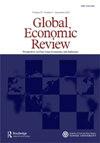Labour Share and Economic Growth in OECD Countries
IF 2.6
4区 经济学
Q2 ECONOMICS
引用次数: 2
Abstract
ABSTRACT We propose a theoretical model that economic growth rate is a strictly concave function of labour share: Growth rate increases with labour share and decreases after reaching the peak. If wage rates are determined through bargaining between labour unions and employers instead of competition in markets, the labour share deviates from the competitive equilibrium level. When this occurs, the economic growth rate is lower than that in the competitive equilibrium, and the growth rate decreases with the increasing labour share. Our empirical analyses of the 23 OECD countries’ balanced panel between 1980 and 2008 confirm our theoretical model.经合组织国家的劳动份额与经济增长
本文提出了经济增长率是劳动份额的严格凹函数的理论模型:增长率随着劳动份额的增加而增加,达到峰值后下降。如果工资率是通过工会和雇主之间的谈判而不是通过市场竞争来决定的,那么劳动份额就会偏离竞争均衡水平。当这种情况发生时,经济增长率低于竞争均衡,并且增长率随着劳动份额的增加而下降。我们对经济合作与发展组织(OECD) 23个国家1980年至2008年的均衡面板进行的实证分析证实了我们的理论模型。
本文章由计算机程序翻译,如有差异,请以英文原文为准。
求助全文
约1分钟内获得全文
求助全文

 求助内容:
求助内容: 应助结果提醒方式:
应助结果提醒方式:


